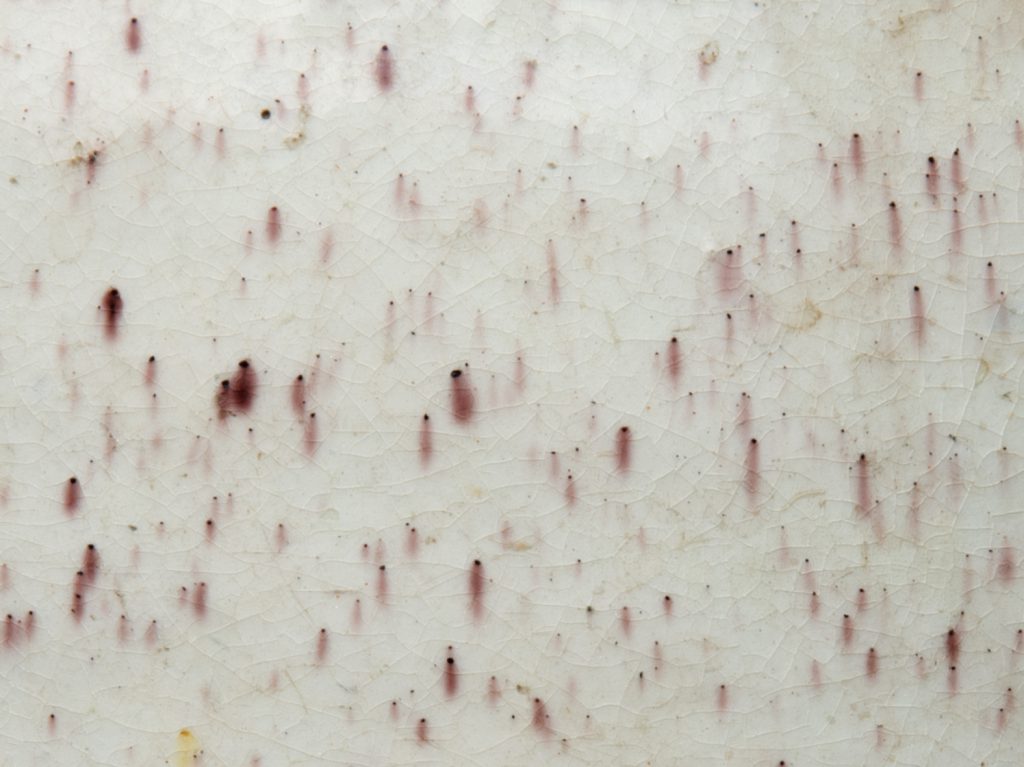
Andreas Heege, 2019
Speckled decoration (iron manganese particles in the slip) in CERAMICA CH
Decorative technique used after 1800 throughout the German-speaking part of Switzerland, in Liechtenstein and in Vorarlberg but, remarkably, not in Baden-Württemberg or Bavaria. Rare examples have also been found in the French-speaking areas of the Cantons of Fribourg and Jura which means that such wares may also have been produced there. The decorative effect is caused by colour particles in the slip. It is achieved by adding ground manganese dioxide or black iron oxide to white slip. There are various processes that produce iron-manganese compounds; forging, for instance, generates large amounts. When a vessel is fired, the lead glaze melts, leading to a partial or complete solution of the metal. The metal specks, which range in colour from manganese purple to black-brown, become liquefied. One variation of this type of pottery was to use yellow or green instead of colourless glaze and then add slip trailing or splashed decoration. In open vessels (plates and bowls), the underside is sometimes covered in red slip.
The effect achieved by this technique looks very much like and is therefore easily mistaken for Faïence blanche mouchetée (white faience with finely dispersed splashed decoration).

Faïence blanche mouchetée, Bern-Brunngasshalde, c. 1800 (photo Badri Redha, Archaeological Service of Canton Bern).
Faïence blanche mouchetée, however, involved splashing manganese purple or more rarely, green glaze onto a white faience glaze (Heege 2010, Fig. 52; Babey 2003, 163 Fig. 22). It was therefore a form of “in-glaze technique”, while iron manganese particles in the slip were located under the glaze and melted into the zone of contact between the slip and the glaze (“under-glaze technique”).
Translation Sandy Haemmerle
German: Farbkörper in der Grundengobe
French: décor moucheté (mouchetis ferro-manganique ou pigments de manganèse à l’engobe blanc)
References:
Babey 2003
Ursule Babey, Produits céramiques modernes. Ensemble de Porrentruy, Grand’Fin (Cahier d’archéologie jurassienne 18), Porrentruy 2003.
Bourgarel 2018
Gilles Bourgarel, L’atelier de potiers de Bulle-Rue de la Poterne (1765-1895), in: AS – Archäologie Schweiz/SAM – Schweizerische Arbeitsgemeinschaft für die Archäologie des Mittelalters und der Neuzeit/SBV – Schweizerischer Burgenverein, Die Schweiz von 1350 bis 1850 im Spiegel archäologischer Quellen. Akten des Kolloquiums/Actes du Colloque Bern, 25.–26.1.2018, Basel 2018, 337-359, bes. Pl. 8,1-4.
Heege 2010
Andreas Heege, Keramik um 1800. Das historisch datierte Küchen- und Tischgeschirr von Bern, Brunngasshalde, Bern 2010, bes. 78-79.
Heege 2016
Andreas Heege, Die Ausgrabungen auf dem Kirchhügel von Bendern, Gemeinde Gamprin, Fürstentum Liechtenstein. Bd. 2: Geschirrkeramik 12. bis 20. Jahrhundert, Vaduz 2016, bes. 90.
Heege/Kistler 2017
Andreas Heege/Andreas Kistler, Keramik aus Langnau. Zur Geschichte der bedeutendsten Landhafnerei im Kanton Bern (Schriften des Bernischen Historischen Museums 13), Bern 2017, bes. 167-168.

